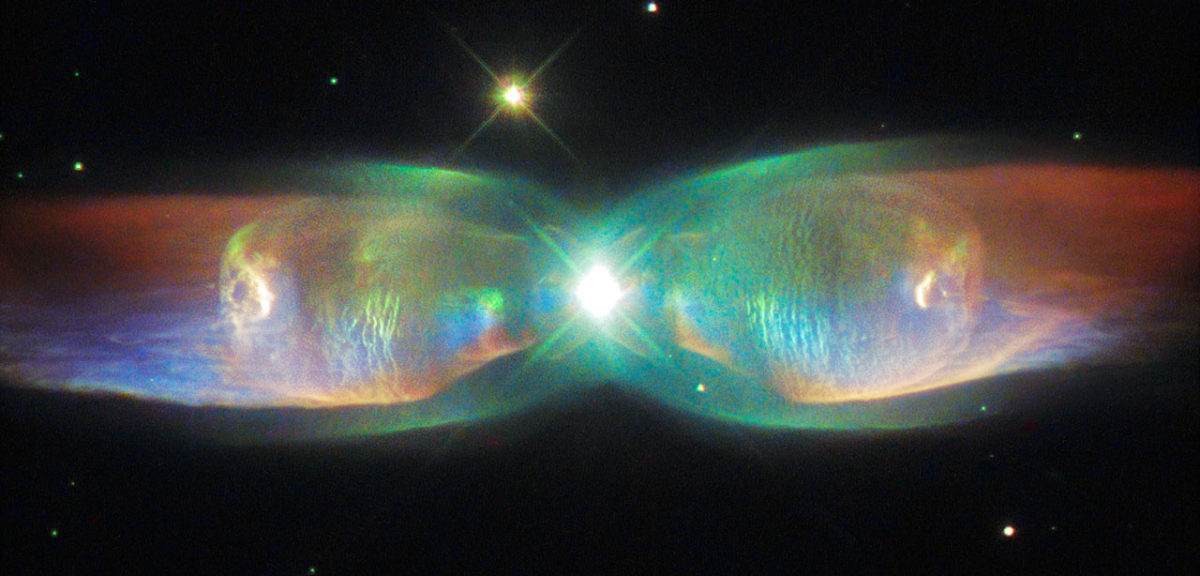
The shimmering colors visible in this NASA/ESA Hubble Space Telescope image, released 8/24/15, shows off the remarkable complexity of the PN M2-9 Twin Jet Nebula which is also known as Minkowski’s Butterfly, the Wings of a Butterfly Nebula or simply Butterfly Nebula. The luminous nebula is about 2,100 light-years away from Earth. Unlike ordinary planetary nebulae which has one star at their center, this is a bipolar nebula which has two stars from a binary star system. (ESA/Hubble & NASA)

A technician is seen here on 8/21/15 working on a central mirror of the Millimetron space observatory at Reshetnev Information Satellite Systems. The company is located in the Siberian town of Zheleznogorsk, outside Krasnoyarsk, Russia (Reuters)

The International Space Station crew grabbed this photo of Typhoon Soudelor as it advanced on Taiwan 8/5/14 (NASA)

Inigo Munoz Elorza of Spain (L) and Stefan Dobrovolny of Austria (R) take stone samples on 8/7/15 during a simulated Mars mission on Tyrolean glaciers in Kaunertal, Austria. The Austrian Space Forum sent some of its researchers to practice weight-less walking in spacesuits on a glacier which resembles the terrain on Mars. (Reuters)

Lava erupts from the Piton de la Fournaise “Peak of the Furnace” volcano, on the southeastern corner of the Indian Ocean island of Reunion Saturday on 8/1/15. Piton de la Fournaise is one of the most active volcanoes in the world and is currently erupting on this Indian Ocean island. (AP)

A bioreactor stands in the production facilities of Protein Sciences in Pearl River, New York, Tuesday on 8/18/15. Protein Sciences is among the companies working on a greater variety of vaccine options for the coming flu season. The company’s genetically engineered vaccine called Flublok was developed for people allergic to eggs. Those with egg allergies are unable to receive regular flu vaccines. (AP)

Mmmmm, space lettuce! Expedition 44 crewmembers aboard the International Space Station sampled their harvest of a crop of “Outredgeous” red romaine lettuce on 8/10/15. The lettuce was grown with the ISS’ veggie plant growth system that tests hardware for growing vegetables and other plants in space. (NASA)

With the promise of a nice lunch of anchovies, Humboldt Penguins are led to the weighing scales at London Zoo on 8/26/15. The Zoo held its annual weigh-in where the vital statistics of animals were taken in an aid for keepers to detect pregnancies and check the animal’s general well being. (AP)

Technicians check out the CALorimetric Electron Telescope (CALET) and Flight Crew Interface Test (FCIT). CALET, which was sent to the International Space Station on 8/24/15 aboard a Japan Aerospace eXploration Agency (JAXA’s) resupply spacecraft, will search for signatures of dark matter and provide the highest energy direct measurements of the cosmic ray electron spectrum. (NASA)

On 8/5/15, NASA’s Curiosity Mars rover took a low-angle self-portrait of itself from above the “Buckskin” rock target in the “Marias Pass” area of lower Mount Sharp. (NASA/JPL-Caltech/MSSS)

This is a new image, released 8/24/15, of the globular cluster NGC 1793 that was taken with the Advanced Camera for Surveys (ACS) on board the NASA/ESA Hubble Space Telescope. One of the biggest globular clusters in the Large Magellanic Cloud this cluster, located nearly 160,000 light years from Earth, was discovered by John Herschel in 1835. (ESA/Hubble & NASA)

The European Space Agency’s ninth and tenth Galileo satellites are being fueled by technicians wearing protective SCAPE suits within the Guiana Space Center’s 3SB preparation building on 8/24/15. The satellites are scheduled to be launched on 9/10/15. (ESA/CNES/ARIANESPACE-Service Optique CSG JW Guillon)
























Comments are closed.